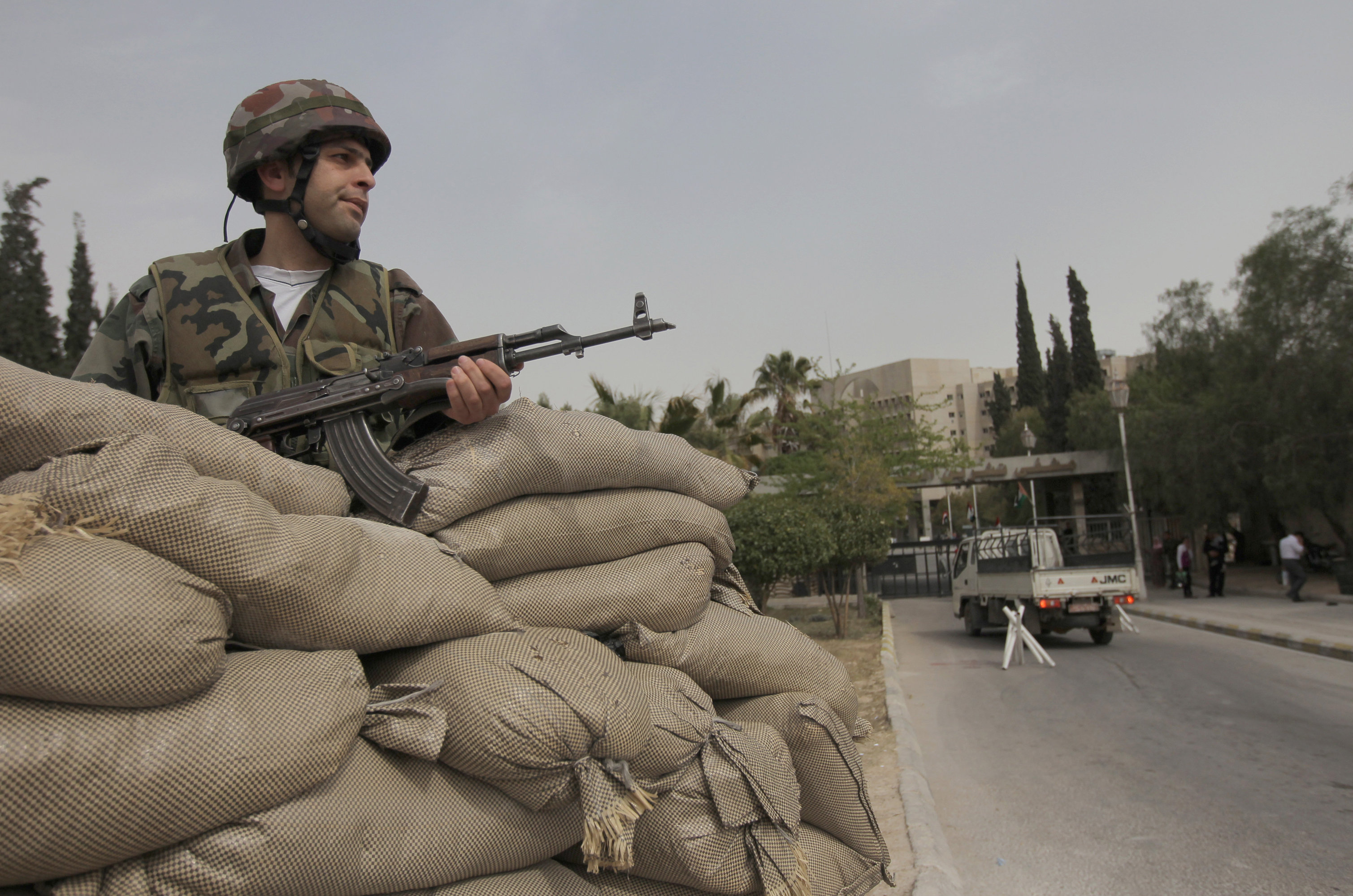MOSCOW, September 4 - RAPSI, Ingrid Burke. During the month of August, there were 5,440 casualties in Syria, and 4,114 of those killed were civilians, a spokesman for the Syrian Observatory for Human Rights confirmed for RAPSI Monday. These numbers were gathered by the group’s monitors on the ground throughout the war-ravaged country. As would be expected in the context of any civil war, each side has made a habit of blaming the other for those atrocities most offensive to international humanitarian law. And perhaps just as unsurprisingly, the major international super powers filling the ranks of the UN Security Council (UNSC) have been unable for months now to agree on a game plan.
If considering all of these points your mind just drifted off to Kosovo circa 1999 as ethnic violence reached the boiling point that prompted NATO to go rogue, you’re not alone. Speculation of a military intervention in Syria nearly predates the present conflict there. In light of Bosnia, Kosovo, Afghanistan, Iraq, and most recently Libya, some can’t imagine why the West wouldn’t intervene in Syria. In keeping with its usual role of shedding light on complex topics rather than picking sides, RAPSI has decided to take a closer look at the international legal issues at the heart of the Syrian intervention question.
Intervention under Chapter VII of the UN Charter
Chapter VII of the UN Charter vests the UNSC with broad power to maintain or restore international peace and security in cases where such is sincerely threatened or breached. This chapter has served as the basis for some of the UN’s most high-profile international justice initiatives, from the creation of the International Criminal Tribunal for the Former Yugoslavia (ICTY) to last year’s Libya intervention. As suggested by the latter, Chapter VII goes so far as to explicitly provide for the use of force in certain, dire contexts.
According to Article 42 of Chapter VII: “Should the Security Council consider that [various economic and diplomatic sanctions] would be inadequate or have proved to be inadequate, it may take such action by air, sea, or land forces as may be necessary to maintain or restore international peace and security. Such action may include demonstrations, blockade, and other operations by air, sea, or land forces of Members of the United Nations.”
While this provision is fairly straight forward, the key issue is clear: any action taken in accordance with Article 42 requires something of an agreement, at least between the five permanent members of the UN: Russia, China, France, the US, and the UK. Each of these five member nations has a veto power that can singlehandedly derail any substantive Chapter VII initiative.
The 1990s were replete with mass atrocities that endured unabated by the UNSC’s Chapter VII powers. Somewhere in the aftermath of the horrors that engulfed Rwanda, the Balkans, Darfur, and more through the course of the decade, the Responsibility to Protect (R2P) was adopted as an international legal norm meant to establish guidelines for the compromise of sovereignty in cases where national governments were unable or unwilling to protect their own people from atrocities.
Intervention under the Responsibility to Protect (R2P)
While it is widely accepted that R2P was born of the international community’s many failures to act in the 1990s, experts have divergent views of its roots.
The Public International Law & Policy Group (PILPG) published a memo last month entitled Humanitarian Intervention in Syria: the Legal Basis. According to PILPG experts, the codification of R2P—which had come to be recognized as a form of international customary law during the course of the 1990s—began in 2001, when the International
Commission on Intervention and State Sovereignty (ICISS) established a set of criteria by proposing the following six-part test for the use of force in the context of humanitarian crises:
1. There must be just cause
2. Use of force must be applied as a last resort
3. The intentions of the acting states must be good
4. Any action taken must be proportionate
5. There must be a reasonable chance of success
6. The action must be authorized by a legitimate authority
According to the memo, the UN General Assembly and the UNSC went on to endorse the R2P doctrine in various contexts, thus confirming its status as an important facet of public international law.
One such context was that of the 2005 World Summit Outcome Document (WSOD), wherein the UN General Assembly recognized the R2P as an emerging international legal norm.
Two key paragraphs of the WSOD breathe life into the R2P. Paragraph 138 lays out the justification for compromising sovereignty, explaining that, “Each individual State has the responsibility to protect its populations from genocide, war crimes, ethnic cleansing and crimes against humanity…. We accept that responsibility and will act in accordance with it.”
Paragraph 139 establishes options for R2P action, and imposes restrictions on their use by stating, “we are prepared to take collective action, in a timely and decisive manner, through the Security Council, in accordance with the Charter, including Chapter VII, on a case-by-case basis and in cooperation with relevant regional organizations as appropriate, should peaceful means be inadequate and national authorities manifestly fail to protect their populations from genocide, war crimes, ethnic cleansing and crimes against humanity.”
The PILPG, that is, seems to interpret the R2P as providing a means for action in cases of Security Council inaction. In the memo, its experts explained, “If the Security Council is deadlocked…. as it was in Kosovo, R2P provides a framework for the international community to legally intervene without Security Council authorization.”
With regard to the Syria situation specifically, the memo points to the three Syria resolutions that UNSC members have failed to see eye to eye on in recent months, and explained that in light of this stalemate, “the international community—either through a regional coalition or a coalition of the willing—has a right under customary international law to use force in Syria for the limited purpose of stopping atrocity crimes, provided that the force is narrowly tailored to accomplishing this humanitarian goal.”
University of Rome International Criminal Law research fellow Joseph Davids argues to the contrary that the R2P section in the WSOD explicitly narrows the R2P as understood by the earlier ICISS document. He argued that the greatest flaw of the PILPG memo, “is that it presupposes what it desires to prove, the validity of R2P’s permissive stance on military intervention outside of the framework of the UN Security Council.” In Davids’ view, “The principle of R2P did not make the jump to [the] realm of real law (soft as it may be) until the [WSOD] where the UN General Assembly endorsed R2P’s main idea of sovereignty as responsibility. The prong providing for military intervention, however, was significantly modified. Intervention was limited to those situations where the UN Security Council authorizes military action.”
A look back at the text of the WSOD quoted above militates in favor of Davids’ interpretation. Paragraph 139 explicitly refers to the UNSC and Chapter VII should peaceful means prove inappropriate, not to military intervention in and of itself. As discussed above, Chapter VII arms the UNSC with broad powers, not any other authority—including those that might be deemed legitimate under the ICISS test.
If the latter interpretation is right, and the R2P does not in fact provide a means for sidestepping an indecisive UNSC, it would seem as though the norm does little more than serve as an outlet for the international community’s collective sense of guilt over the mass atrocities of the 1990s.
Speaking with RAPSI Monday, Davids argued however that the R2P creates accountability where it was so often lacking in the past, explaining that the norm “aims to create an international obligation to act in the face of atrocities. It aims to create obligations to prevent international crimes and to rebuild after they have occurred in addition to intervene to put them to an end. While it has failed to provide a separate legal basis for military intervention, R2P has created a new vocabulary for talking about how to deal with these kinds of situations through its language of preventing and rebuilding.”
Alternative grounds for a Syria intervention
Asked whether a nation or coalition interested in intervening in Syria might do so based on an alternative legal theory, Davids explained that this would only be realistic if the Assad regime were to request a military intervention, a fairly unlikely prospect. According to Davids, “The legal grounds for intervention are in this kind of case: (1) self-defense, (2) Security Council authorization and (3) invitation. The first two seem unlikely given the political deadlock at the council and the internal nature of the conflict. The third could happen if a State (not an armed group in a State) requests that another State come to its aid. Also seems unlikely if things hold the course they have been taking. Outside of these three possibilities, there is no legal justification for military intervention.”
Political angle
International legal norms surrounding intervention, such as Chapter VII and the R2P are rapidly evolving. Military intervention has proven problematic under various theories of international law through the course of its existence. A great many critics still vehemently maintain that NATO should have stood trial at the ICTY for its intervention in Kosovo.
In light of this, Davids brought up a crucial point in stating: “R2P, unlike previous versions of ‘humanitarian intervention’ doctrines, was an attempt to create legally binding criteria to justify international action. The idea was to take intervention out of the realm of political action. The problem is that the determination of whether the legal criteria has been met turns into a political morass recreating the same problem at a later stage of the decision making process.”
Love it or hate it, the UNSC is by its nature a political beast. If you agree with the PILPG, it’s a beast that can be circumvented. Still, as explained by Davids, the text of the relevant law would seem to militate otherwise.
A lot has changed since Kosovo, and these changes have taken a significant toll on the likelihood that any interested nation or coalition thereof can legitimately intervene regardless of the horrific details emerging from the chaos.



